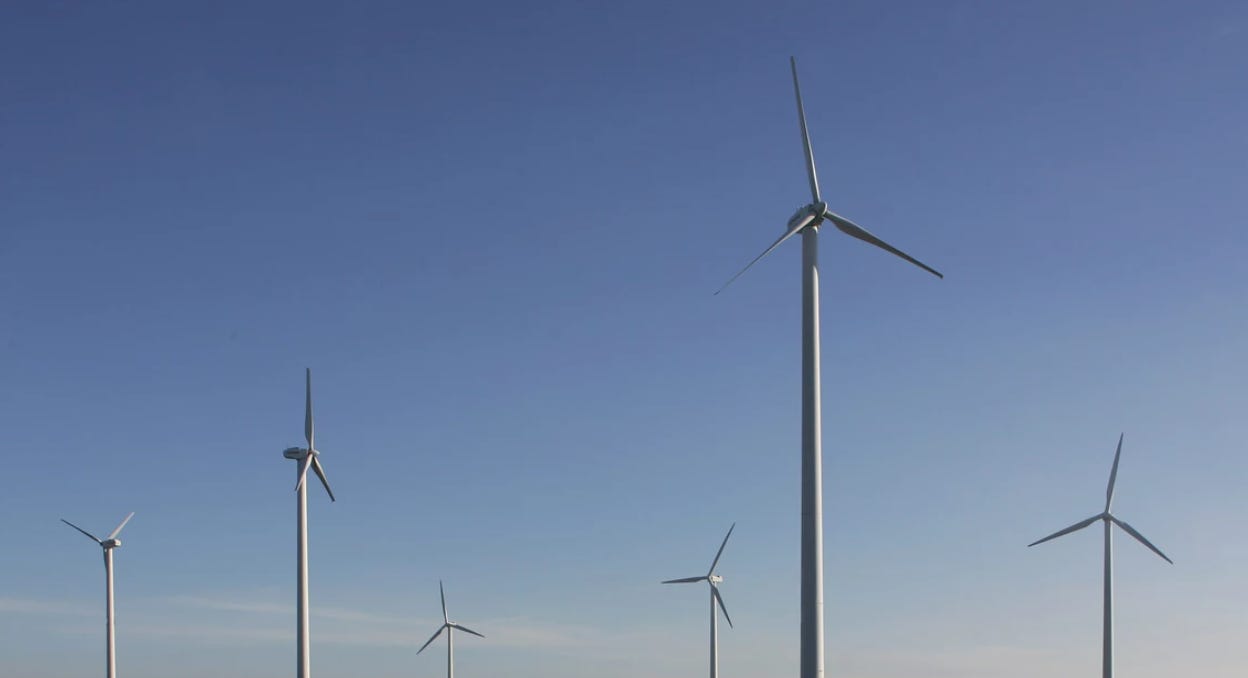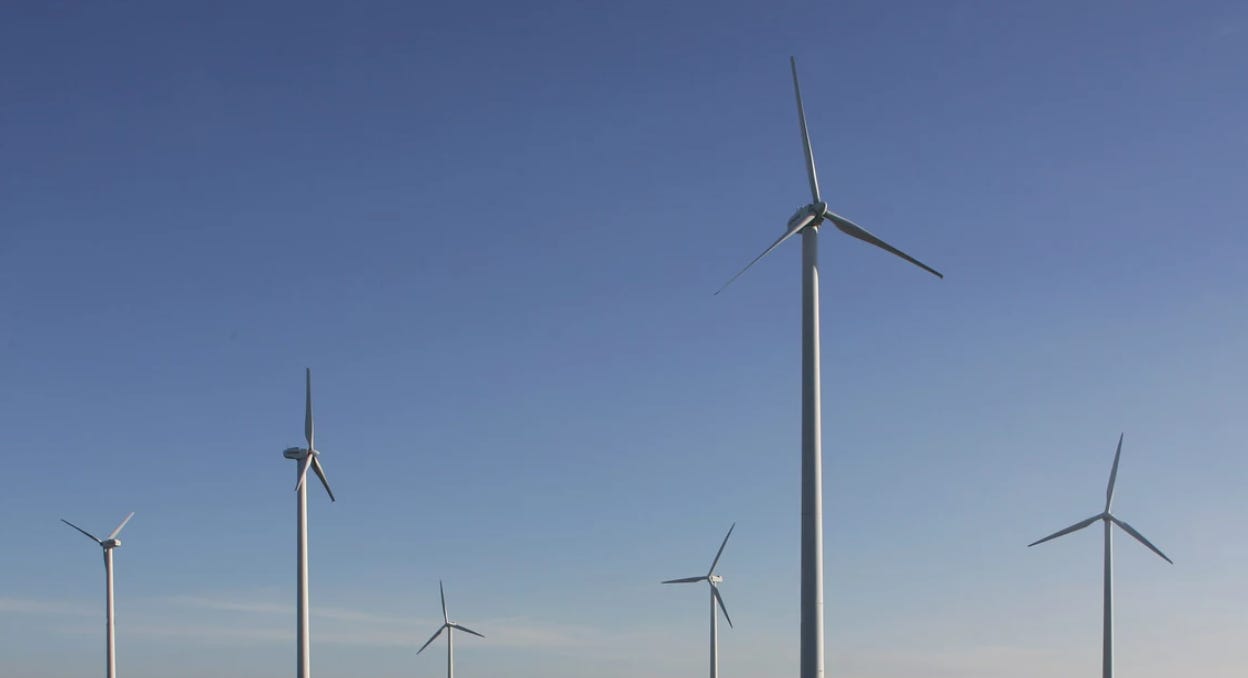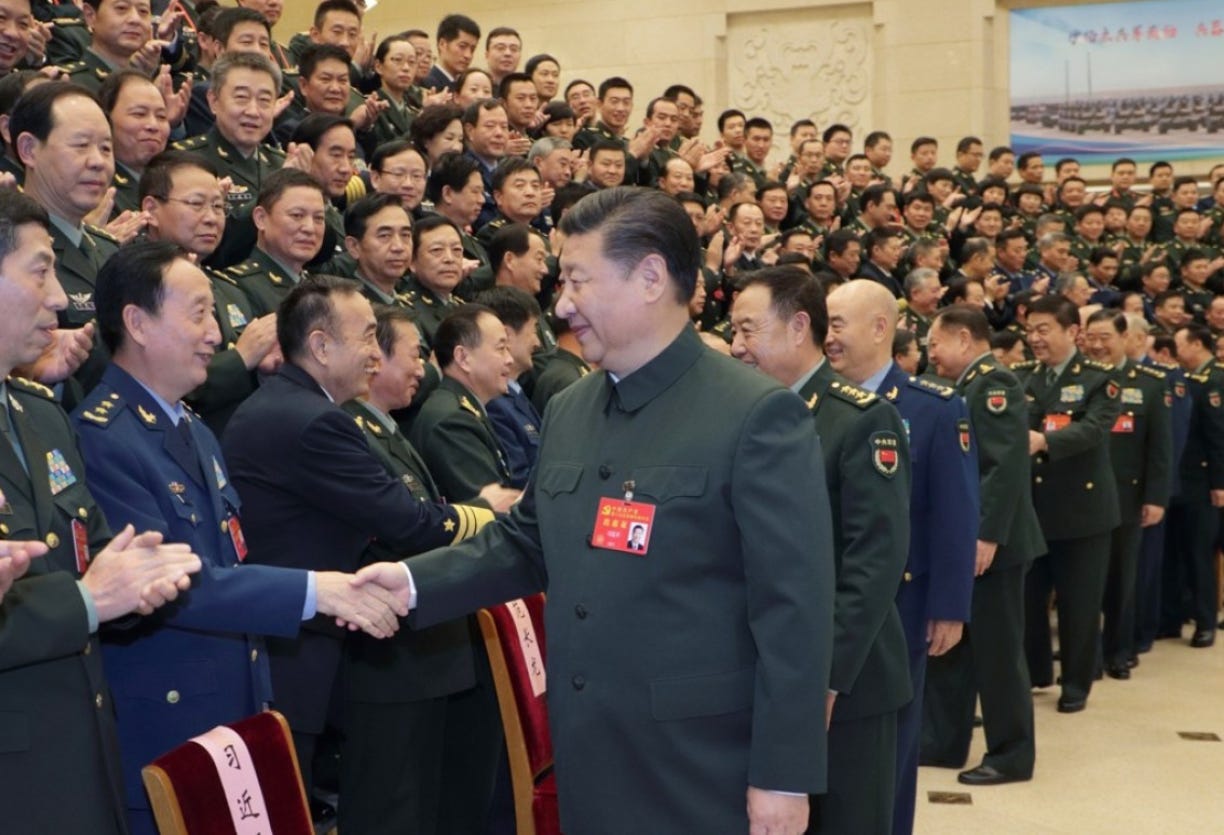
One cannot drive any significant distance in South Dakota without seeing significant numbers of wind turbines in the fields. Their blinking red lights (hazards to air navigation) are particularly pronounced at night. Having always wondered about the enormity of the public investment required (i.e., the taxpayer subsidies involved), thinking about all those wind turbines stimulated a recent Grok query about the total number of wind turbine projects and turbines in the state. The results are provided below (emphasis added):
Number of Wind Turbine Projects: South Dakota has at least 25 wind farms operational or approved, with additional projects under consideration. This number comes from reports indicating that eight major wind energy projects were approved between June 2018 and July 2019, and two others were in the regulatory approval process, raising the total from 15 wind farms in 2017 to 25 by 2020. More recent projects, such as the Deuel Harvest Wind Energy South (approved in 2025), suggest the total may be slightly higher, but 25 is a conservative estimate based on confirmed data.
Total Number of Wind Turbines: As of July 2022, South Dakota had 2,811 wind turbines generating 5,525 megawatts (MW) of electricity. This figure includes a significant increase from 526 turbines before 2019 to an additional 511 constructed between 2019 and 2021, with further projects adding to the total. More recent projects, like the North Bend and Sweetland Wind Farms (each with 71 turbines) and the Deuel Harvest Wind Energy South (up to 68 turbines), indicate continued growth, but the 2,811 figure is the most comprehensive recent count.
Context and Capacity: South Dakota’s installed wind energy capacity was approximately 3,618 MW in 2023, with 399 MW added that year. The state ranks 13th nationally for installed wind capacity and second for the percentage of electricity generated from wind (55% in 2023). Key projects include the Deuel Harvest Wind Farm (109 turbines, 301 MW), Dakota Range I & II (72 turbines, 304 MW), and smaller projects like the South Dakota Wind Energy Center (27 turbines, 40.5 MW).
Two thousand eight hundred and eleven wind turbines did not magically spring up over the South Dakota plains. The first wind turbine project approved in South Dakota was the South Dakota Wind Energy Center in Hyde County in 2003. The sales pitches for wind farms have been honed since then but generally include a combination of the siren song of long-term financial incentives to landowners, no upfront costs, small footprint, easy coexistence with agriculture, saving the planet through “renewable” energy production, boosting the local economy (good neighborliness), etc.
Then there are the federal taxpayer subsidies which make these projects viable in the first place, and which explain why no turbines were installed before 2003 (before congressional greenies implemented them). These include:
Production Tax Credit (PTC). The PTC is a per-kilowatt-hour (kWh) tax credit for electricity generated by wind turbines, paid over the first 10 years of operation. In 2024, the PTC cost federal taxpayers approximately $7.5 billion, with projections of $276.6 billion from 2024–2033.
Investment Tax Credit (ITC). This is a tax credit covering a percentage of the capital cost of wind project equipment that is used for upfront financing. In 2024, the ITC cost federal taxpayers $27.5 billion, with a projected $148 billion from 2024–2033.
Accelerated Depreciation (MACRS). This allows wind project owners to depreciate capital costs over a 5-year schedule, reducing taxable income during that period. Note: This lowers tax liability significantly for developers (incentives for development!).
Putting these subsidies in context, per unit of energy, wind subsidies are very high. For example, in 2010, taxpayers paid $56 per megawatt hour for wind compared to $0.64 for coal or gas, though green energy advocates claim efficiency gains have reduced this gap (unspecified).
As an aside Just the News provided some shocking figures on green energy investments versus outcomes last month: “Since 2010, $9 trillion has been spent globally on wind, solar, electric vehicles energy storage, electrification and power grids, but despite this expensive effort — mostly at taxpayer expense — the share of final energy consumption by carbon-free energy sources is advancing by approximately a scant 0.3% to 0.6% per year.” The US share is nearly $1 trillion. Imagine what that money could have done to repair all the roads and bridges across the US over the same timeframe! Lastly, the US national debt is currently greater than $36.7 trillion, and yet the green energy tax subsidies continue ad infinitum without regard to a looming catastrophic bankruptcy of the country.
DIRTY LINEN
There is far more to the wind farm sales pitch and siren’s song, as explained by Gregg Hubner, a long-time anti-wind turbine activist from Avon, SD. In 2017, Hubner wrote a book detailing concerns about wind turbines based on his own analysis and direct experiences entitled, Paradise Destroyed: The Destruction of Rural Living by the Wind Energy Scam. He has been lobbying against and speaking the unspoken about wind turbines at landowners’ rights meetings for years. He tells his own story from direct experience with a message that includes the following parts:
- The evolution of the citing process from 2010 till now including his personal experience
- The easement contract and its repercussions
- The surprises for which individual landowners should be ready
Several wind turbine companies pursued permit applications with the South Dakota PUC for a project in in Bon Homme County from 2013-2020. Local landowners were unorganized and relatively unsophisticated in their approach to attempt to thwart the proposed project(s), but they nevertheless testified in various PUC public meetings and during open hearings in the state legislature, as appropriate.
Meanwhile, the wind companies successfully lobbied the state legislature and governor’s office, resulting in the passage of Senate Bill 157 (the “Permit Bill”) in 2020 that gutted the previous conditional use permit (CUP) processes that had been established in various counties. The bill was sold as a means of reducing roadblocks to economic development by removing county-level impediments and expediting approvals for projects like wind farms that required CUPs. The bill established uniform rules for how counties handle CUP applications, addressing the previous patchwork of county-specific zoning and permitting regulations that ranged from nonexistent to highly restrictive. This ensured a more predictable process for developers seeking permits (and significantly reduced their permitting and legal costs).
One key provision of the bill set a 21-day window for appealing a county’s CUP decision, shorter than the typical 30-day appeal period in South Dakota codified law, which tipped the scales from individual landowners to developers.
Another provision narrowly defined who qualifies as an “aggrieved person” eligible to appeal a permit decision, which had the intended effect of limiting challenges to only those directly impacted (e.g., nearby landowners) and reducing any challenges from broader land owners’ rights and other opposition groups.
For all practical purposes, passage of SB157 shut down citizen resistance to wind farms, just as the bill was always intended to do: development won out over individual property rights.
Hubner’s experience with the wind turbine company was problematic. He was pitched that 12 towers on 1800 acres would be implemented over the course of the proposed project (150 acres per turbine), with total financial incentives calculated at $7,500 per turbine time 12 turbines times 30 years, or $2,886,000. The reality was that a total of 57 turbines were installed over the 26,000-acre project, equating to 456 acres per turbine and overpromising on lease costs by 300%!
OTHER SECRETS NOT WIDELY KNOWN
With a typical wind turbine lease agreement, there are three clauses that affect landowners in ways not widely known or understood.
Effects Clause. This deals with easement requirements and protects the wind farm developer’s ability to maintain optimal wind flow to the turbines. It generally restricts the landowner from engaging in activities or making changes to their property that could interfere with the wind resource or turbine operations. The negative effects on the landowner include limiting future land use improvements (e.g., building new structures, planting windbreaks, etc.), binding land use improvements on future generations or property buyers (agreements could be up to 40 years), and restricting development on land not directly leased for turbines (“adjacent” properties).
Confidentiality Clause. This is a provision that restricts the landowner from disclosing specific details of the agreement or proprietary information related to the wind farm project and is designed to protect the wind energy developer’s business interests, project details, and competitive advantage while ensuring sensitive financial or operational information remains private. A confidentiality clause restricts a landowner from openly discussing lease terms with neighbors, which hinders collective bargaining or community discussions about wind farm impacts, as well as creating tension in small rural communities where trust is always key to good neighborly relations. Who knows what deal (or operating restrictions) one’s neighbor agreed to if all agreements are confidential?
Good Neighbor Agreement (GNA). This is a contract between the wind energy developer and landowners who own property near a wind farm but do not host turbines on their land. Its secures cooperation from these neighboring landowners to ensure the wind farm’s “operational efficiency,” in particular to prevent future actions that could interfere with wind flow or general project development. A GNA typically includes a confidentiality clause prohibiting a landowner from disclosing payment amounts for incidentals and associated project development details. A GNA constrains future land use improvements, including the ability to build tall structures, plant windbreaks, or develop other projects within restricted areas cited in the agreement.
Note: The confidentiality clauses come with teeth in them, as breaches open a landowner up to legal consequences including significant fines. A landowner discusses his deal with a wind developer with a neighbor, family member, or friend in town at this own peril!
CONCLUDING THOUGHTS
Lastly, there are some unwelcome surprises that wind turbine agreements inflict on unwitting landowners and rural communities:
- The signed wind turbine agreement may not deliver any of the wind turbines proposed (no minimum number of turbines specified on one’s land)
- The confidentiality agreement remains binding even if one does not have a single turbine installed
- The promised economic development for the local area does not materialize (construction crews swoop in from out of area and leave when the projects are done; even power company reps and regulators typically live outside the county)
- The dirty little secret of infrasound can wreck a person’s health (ask Gregg Hubner about that, as he sleeps in his basement to avoid the ill effects of a turbine near his house)
The push for economic development in South Dakota isn’t all it was cracked up to be insofar as wind turbines are concerned. You may wish to contact Hubner if your county is in the throes of evaluating the pros and cons of a proposed new wind turbine projects (and read his book for starters).
There are a host of other reasons why green energy projects are a testament to man’s foolish attempts to rewrite the laws of physics, but I will save those for future articles.
The end.




